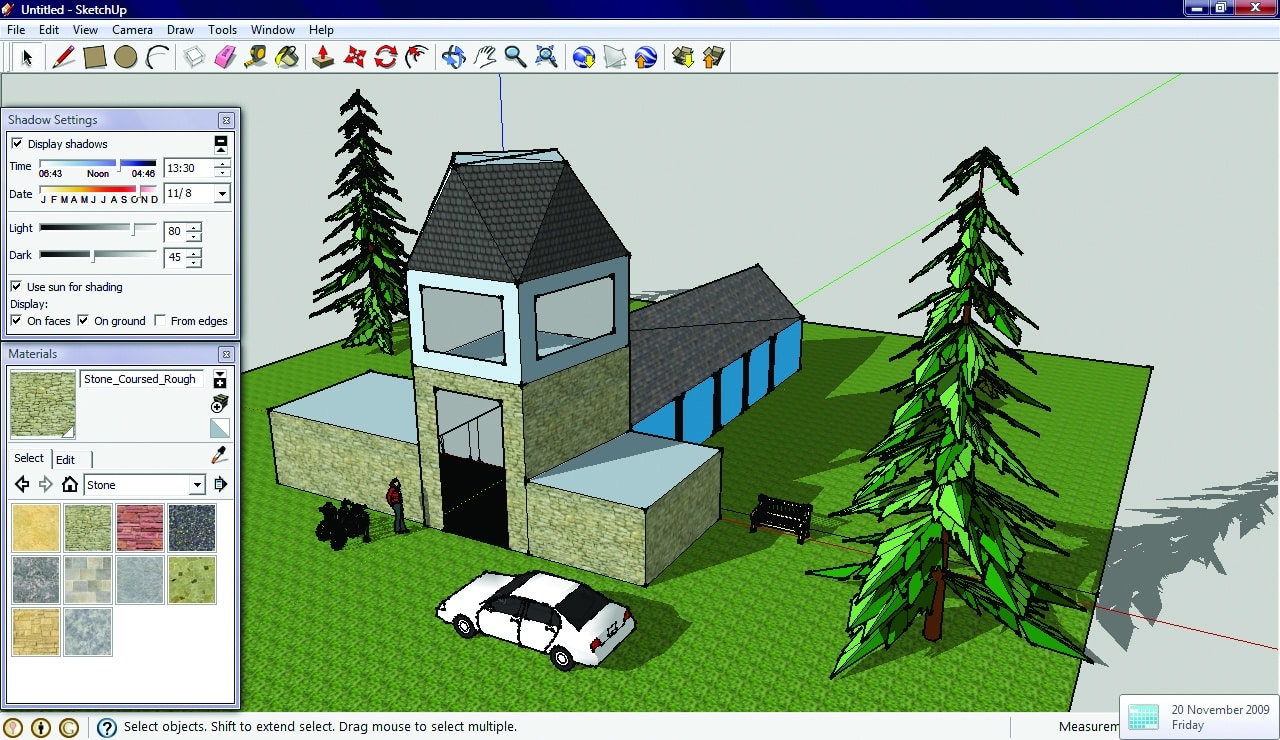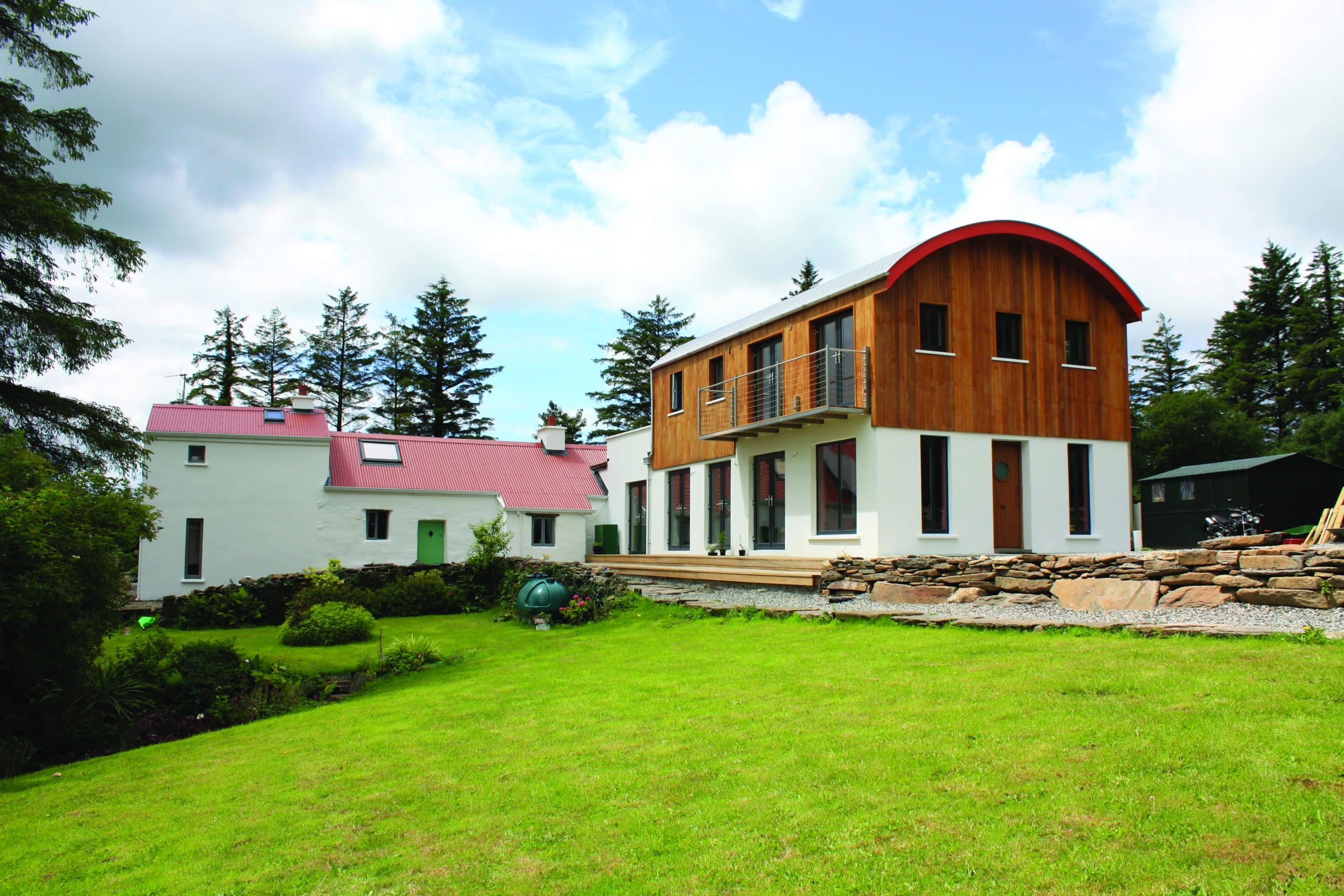Architects occupy an unusual and possibly
unique place in our society. Unlike solicitors
or your bank manager for example, you are
likely to be involved with an architect on a single occasion during your life. When you are, the relationship is extremely personal and emotional, and, whilst you will be paying them, you will be
contributing to the outcome to a greater or lesser degree yourself.
There is a great deal of faith and trust involved in this relationship, born partly out of ignorance, because few of us understand the design process before we get involved. This article therefore is all about providing you with a better understanding of the design process and to create a stronger bridge between your expectation and what the architect delivers. These expectations range from the client who asks, shortly after I arrive on site, for my ideas on a potential winning design, to one who has decided on a particular scheme and is convinced this is the only solution to the problem. Whilst the following is mostly based on my own experience, I will be referring to other architects to give a balanced view.
It’s a process that starts very simply with the client and their site. As the project develops, more strands are added and some bigger than others, but all must remain active, with the aim being to combine these into a single whole – your house – by the conclusion.
Strand 1: Site or Existing Property
Obtaining accurate measurements for the site or property to ensure the design fits correctly seems like stating the obvious, but I have heard many nightmare accounts of house designs unable to be transferred to the site.Accurate values result from a measured survey of the site or house which should always be done before any design work is started. Whether it’s the exact size of existing rooms or the levels across the site, you need to know what the base points are. Without exact scale drawings it is impossible to communicate accurately the elements of what is proposed.
This is probably the most critical strand of all because of the enormity of the consequences if it’s incorrect; you cannot change where the sun rises and sets nor the direction of prevailing winds, for example.

Strand 2: Budget
Designing a mansion when the budget is only enough for a molehill is a recipe for disaster; architects, at all stages of the project need to understand the implications of their designs in terms of money. The initial basic sketch is priced on a per square foot or metre basis; prices have dropped considerably over the last year, from a basic ‘builders specification’ of approximately €100/sqft down into the €80’s/sqft. This is
particularly critical towards the end of the project; the cost of €30/sqyd for tiling sounds inexpensive, but the price escalates when multiplied by a large area, especially important when builders give a provisional sum for the tiling in total.
Strand 3: Owner
Architects are individuals, some of whom wish to fulfill their own desires through your house. At the other end of this scale is the architect who reproduces exactly what you have told them. Neither is ideal, the architect’s job is to evaluate all the requirements, constraints and concepts to achieve the right design. The example below shows how (through the clients open mind) the design changed from where he thought the extension should be to where it ultimately was. This change resulted from a simple analysis of spaces required and their best positions in relation to the path of the sun.
Your requirements, ideas and expectations must be reflected in the design brief taken by your architect. The key is not to be too exact and to include a degree of flexibility. You may feel that by fixing on a particular design long before the architect has done any work might save money, but this isn’t using the architects’ skills and if it’s what you require you may be better suited to employing a draughts-person.Adopting this approach means you will miss out on different design alternatives by a professional trained to understand, interpret, design and construct your requirements. Probably the most important part of any brief is the schedule of accommodation; the rooms or spaces you require, their sizes and then the relationship between them. I tend to start my ‘spaces’relationship diagram as simple bubbles and map out how each space relates to the other; it is quite an architectural challenge to achieve something special with spaces that relate to each other in three dimensions as well as in plan.
This client and architect relationship can often be further complicated when the ‘client’ is a couple. We were warned at college that frequently the architect has to combine that role with being a marriage guidance counsellor as you try to resolve different requirements, ideas and detail.
Strand 4: Constraints
Understanding any constraints that the design needs to respond to is also critical, in fact, they can often create an opportunity rather than a problem, for example, a tree that needs to be retained. These constraints must be assessed to decide which are absolutely fixed, those that can be bent a little and finally ones which have no relevance at all. The example shows how the existing garage, trees that needed to be retained and the rock shelf led to the creation of a curved wall design for a contemporary extension to a traditional cottage.
Strand 5: Creating the Design
The software that is available today could only have been dreamed of when I first started on architectural CAD software in the 1980’s. The days of programming lines of a building by hand have long gone and with the arrival of software such as SketchUp, anyone can attempt to design their architectural masterpiece – the screenshot below shows a design from my ten year old (Fionn). That being said, although my preferred method of visualisation is on the computer (I conceptualise and present all my ideas in 3D using VectorWorks), my very first ideas, bubble diagrams and concepts are done with good old fashioned pencil and paper.
Other architects will conceptualise with pencil sketches or using card models. The key is that you as client can understand what the architect is trying to communicate. MacGabhann Architects for example favour the ‘real’ model-making approach,
as Tarla MacGabhann explains:
“We listen very carefully to the client, ‘understand’ their site and combine this with our skill in producing models until we get the right solution.
Sometimes it takes two weeks, sometimes six, to arrive at the solution, and as many as 30 models to come to something we are happy with. We find model building the best method of designing.”
One of my ‘hero’ architects is Australian Glen Murcutt who combines contemporary design with authentic Australian architectural features. Murcutt fits into the ‘old school’ of architecture where hand drawn sketches and drawings dominate; he was
once asked in a student survey to name his ‘favourite site on the web’, Murcutt replied that he much preferred a spider’s web.

Strand 6: Energy
From the earliest sketches, the architect needs to understand the implications of the design in terms of energy performance. With BER (ROI)/SAP (NI) energy certificates now mandatory, that requirement should influence the design in order to achieve the highest energy rating possible, whether it be a newbuild, extension or renovation. Building Regulations require your new house to meet a B1/B2 rating (ROI) or equivalent SAP standard in NI. Your architect does not need to be a BER/SAP assessor but they do need to understand what will achieve a high rating, for example, maximizing solar gain via glazing to the south.
Strand 7: Technical Requirements
The new building must conform to Building Regulations, which are a major influence. Two of these have a major impact on house design. Part B (ROI), part E (NI) (to ensure means of escape in case of fire) which are especially important in a loft type design and for the dimensions of any windows for escape purposes, and Part F (Ventilation –overdue a review) which sets out room heights, and areas, particularly important with the increase in use of heat recovery ventilation systems. Interestingly, what are thought of as the Building Regulations are in fact only ’Technical Guidance Documents’that give one method of meeting the Building Regulations – other methods (that obviously need to comply) are equally as valid.
Strand 8: History and Planning
A house needs to relate to what surrounds it, whether open countryside or as part of a terrace of houses.At the same time, the design must acknowledge the past yet be ‘of its time’. The line between pastiche and modern horror is very thin and it is the architect’s job to create a design that fulfils all the requirements asked of it. The views of your local planning officer will also come into this category; some favour ‘traditional’ designs, others welcome contemporary solutions. Some designers take an easier route and re-configure previously successful drawings.
Strand 9: The Build
There are always questions during construction and I doubt there has ever been a project which did not contain changes during the build. Everyone needs to be able to work together, especially if additional time is spent in evaluating the design (see below on ‘Time’). These ‘late changes’ can have a big effect upon the budget as well and ideally all design work should be complete before construction commences.
Strand 10: Time
Rushing the design in order to get a planning application in is usually short term gain for long term loss. Sometimes it takes time for good design ideas to flow to allow for different ideas to be tested and appraised. Note that any major design changes post planning permission will require another planning application.
The very nature of design is normally that of a cyclical process where ideas are tested, fine-tuned, and polished in what can sometimes become a circuitous route. Glen Murcutt for example puts off designing as long as possible to give the project time to mature in his mind.
Obviously there are limits on how long you should wait for your architect to come up with his design, there may be some deadlines that are impossible to ignore and it’s imperative that you plan and schedule in advance. Planning permissions for site purchases ‘subject to planning’ are frequently given a six month time limit within the vendor’s contract and there is a also a six month limit to respond to a ‘Further Information’request by the planning authority, which may sound a long time but it passes remarkably quickly.
The base point from which the architect begins does to some extent dictate the time required.A level, greenfield site is a lot less problematical a proposition than extending a building on a small site.
Strand 11: Architectural Aspects
Related to the foregoing are a whole gamut of aspects the architect needs to integrate and coordinate in order for the design to progress. Below are a just a selection – this list is not exhaustive.
Ergonomics: All spaces have dimensional requirements based on how you intend using them; bedrooms, for example, need to have space for beds, wardrobes, dressing tables etc. with adequate space around these items in order to allow you to move freely. Part of the architects’ education is an understanding of these space requirements based on ergonomics, the movement of the human body.
In a bathroom where there are also spatial requirements in section as well as plan – the height standing up from a wc for example – they can be critical.A further complication is that different people have different space requirements, either due to size of family (a larger family needs more space), personal experience (you may be used to living in mansion sized rooms), or future aspirations (you hope to live in mansion sized rooms).
Scale and Proportion: A room can be long and thin or tall and wide. The Greeks and Romans based these proportions on mathematics and regarded them as a perfect expression of beauty and harmony. The key proportion used was the ‘Golden Section’, which can be defined as a line cut in such a way that the smaller section is to the greater as the greater is to the whole.

So, it is important that when you are setting up a design team, which is your responsibility to do as the client, that you have a designer who will look after the first two pillars and a quantity surveyor who will look after the third. This is because it would not normally be possible for an architectural designer or engineer to accurately assess the cost of the house they are designing for you. That is not their core competency. Also, houses nowadays are too complex with too many moving parts to estimate its cost with any level of confidence in advance.
Closer to our own age, Le Corbusier developed and integrated the concept of the Golden section with the configuration of the human body in order to unite harmony and “maintain the human scale”. The widespread use of this system by some architects in inappropriate climates is often cited as the reason for the appalling quality of design in post-war buildings across the world. Interestingly, the concept of the Golden Section (which has been shown to occur naturally in everything from sea shells to
babies faces), is frequently used in houses of today. Planners requesting windows that are ‘taller and narrower rather than longer and higher’, will translate into vertical ‘Golden Section’rectangles.
The Japanese have their own measurement system called the ‘Ken’, introduced in the latter half of Japan’s middle ages.As well as being a measurement for the construction of buildings, the ‘Ken’ evolved into an artistic module that regulated the spaces of Japanese architecture.
Generator or Axis Lines: Although space is defined in three dimensions, frequently architects will create a two dimensional ’line’to define a space or to create a view. Generally imaginary and invisible, these lines are often used to guide your eye from one space to another or to allow a view through the building, from entrance through a room to the vista beyond for example.
I hope that this article has helped you to understand just some of the background and thought processes involved in creating a unique piece of architecture, one whose essential feature is that it must also function as your home for as long as you wish to remain there.











